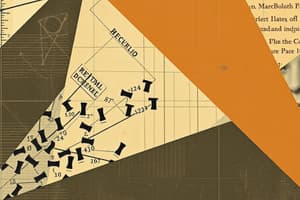Podcast
Questions and Answers
What are the different types of angles that can be formed?
What are the different types of angles that can be formed?
Acute, obtuse, right
A line has two endpoints.
A line has two endpoints.
False (B)
Which symbol represents a ray?
Which symbol represents a ray?
- OP (correct)
- PQ
- AB
- ABC
What is the sum of the measures of two complementary angles?
What is the sum of the measures of two complementary angles?
The angles formed at the intersection of two lines or segments are called ______.
The angles formed at the intersection of two lines or segments are called ______.
Can two acute angles be complementary to each other?
Can two acute angles be complementary to each other?
What is the measure of the complement of a 45° angle?
What is the measure of the complement of a 45° angle?
What is the difference in the measures of two complementary angles if one angle is 12° more than the other?
What is the difference in the measures of two complementary angles if one angle is 12° more than the other?
Study Notes
Introduction to Lines and Angles
- A line segment has two endpoints, while a line extends endlessly in both directions.
- A ray has one endpoint and extends infinitely in one direction.
- An angle is formed when two lines or line segments meet at a point.
- Acute angles measure less than 90 degrees.
- Obtuse angles measure more than 90 degrees but less than 180 degrees.
- Right angles measure 90 degrees.
Related Angles
Complementary Angles
- Two angles are complementary if the sum of their measures is 90 degrees.
- Each angle is considered the complement of the other.
Supplementary Angles
- Two angles are supplementary if the sum of their measures is 180 degrees.
- Each angle is considered the supplement of the other.
Studying That Suits You
Use AI to generate personalized quizzes and flashcards to suit your learning preferences.
Related Documents
Description
Explore the fundamental concepts of lines, angles, and their relationships in geometry. This quiz covers line segments, rays, different types of angles, and the definitions of complementary and supplementary angles. Test your knowledge and understanding of these basic geometric principles.




